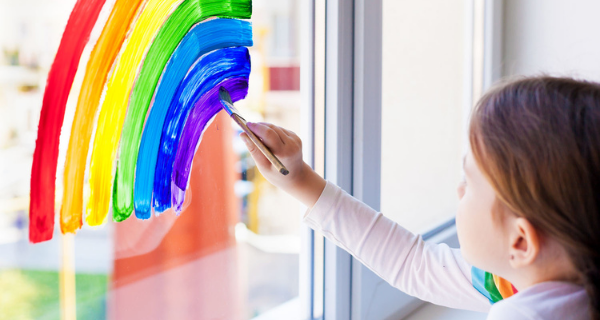
Color Theory Basics
According to color researchers, when users leave a website — to never return (bye, Felicia) — it’s due to poor color choices and bad design choices 52% of the time. That’s huge! And while going through ROY G. BIV may seem pretty elementary, it’s important to anticipate and understand reactions that prospects may have to your brand — and some of those can be based on the colors you choose.
Our understanding and reaction to color is influenced in two main ways. It’s part natural association — the grass is green, and the sky is blue — and part psychology or cultural association — think about how pink and blue are gendered, particularly with young children.
Color can often be overlooked, but it has the power to increase brand recognition by 80%. So, let’s consider each color and what it can mean to consumers in North America.
- Red is the color of firetrucks and alarms. It’s an attention-grabbing, high-energy, power color. Positive connotations with red include: power, courage, and excitement, while some negative connotations include anger or danger. What emotion red triggers generally depends on the context it’s included within. When paired with black, it can appear moody versus when paired with white it can seem more 1950’s classic — think Coca-Cola.
- Orange is a mix of red’s power and yellow’s playfulness creating something that is warm and motivating. It’s a standout color that can bridge between different color themes and can even border on a warm brown-tone. It can conjure up thoughts of seasonality, warmth, vitality, humor, and youthfulness.
- Yellow is the color of daffodils, sunshine, and rubber ducks. It is a warm, youthful color that is often used to grab attention. Positive associations with yellow include: optimism, confidence, self-esteem, and friendliness. Negative associations with yellow include: jaundice, fear, and cowardice. In general, the tone of the yellow tends to swap the negative or positive connotations with brighter yellows leaning more toward positive.
- Blue is one of the most popular colors among consumers. It’s the color of fresh air, water, and often is attached to a notion of health and vitality, which is why so many health corporations use soft blue tones as a branded color. Blue can suggest feelings of trust, dependability, intelligence, serenity, and calm.
- Green is the most common color in nature and is often associated with growth, both in plants and in financial wealth. As such, it’s often in the branded materials of both eco-friendly companies as well as financial institutions. Green can be associated with health, money, wealth, renewal, and harmony.
- Purple, once only a color for royalty, is often used to indicate luxury, loyalty, mystery, and magic. Purple is more commonly used as a secondary, or accent, color in many brand palettes.
- Pink is a tint of red and often soothes rather than stimulates. It’s a caring color which can be used to show happiness, warmth, or love. Pink can also be hopeful, consider the pink breast cancer ribbons. However, including too much pink, can be seen as exclusively-female or depending on usage and tone, childlike.
- Black is the color of night and denotes luxury, glamor, elegance, and sophistication. Black is a serious, reserved color, and is best used to show contrast with lighter colors. Too much black can cause it to be taken negatively and be associated with mourning.
- White is the color of lab coats, freshly fallen snow, and traditional wedding dresses. It can be seen as a color of cleanliness, minimalism, and simplicity. Taken too far, white can make branded elements seem sterile. We often hear the term “white space.” In the art world the term for this is negative space, which is just a fancy way of saying blank space void of design elements. It’s important to note that white space doesn’t necessarily need to be white. Often white space could be a lighter color, the key term to keep in mind here is space, and not white. Giving our designs room to breathe on a page is important to their visual appeal.
- Brown has a serious earth tone. It’s considered a pretty safe, and sometimes boring color. Brown does a great job of grounding or supporting other branded colors. It can connote warmth, reliability, and nature. While brown is a nice, warm-toned neutral color, it is worth noting that sometimes brown can conjure up an impression of dirtiness — which is appropriate for a park — but maybe not for a newly-renovated property or community.
Be Creative + Be Colorful
We believe that good branding sends an intentional message. Dial in your brand colors to take your messaging to the next level. Want to learn more about branding? Check out the G5 MarTech Report: Brand + UX
Get News, Articles & Updates in Your Inbox
Thank You for Your Interest
We will be in contact soon and look forward to learning more about you and your company. Based on your marketing challenges, we’ll discuss increasing visibility into your analytics and how to generate more and better leads so you can achieve your marketing goals.
In the meantime, we invite you to check out our checklist on website accessibility. Use this checklist to start assessing the baseline accessibility of your website.
Enjoy! We’ll be in touch very soon.
